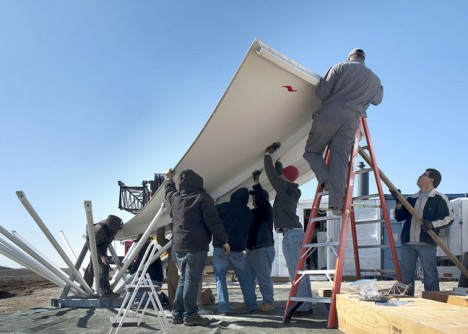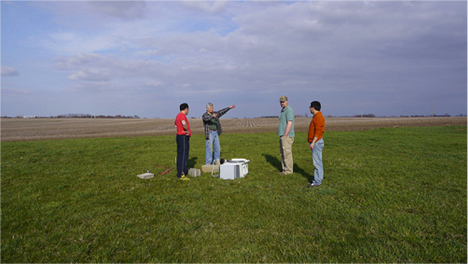Tiny Things Matter
May 23rd, 2013 by Bo Chen
When I heard that student volunteers were needed for IFloodS,
I knew I wanted to take part. I had had little experience with
fieldwork in the past. Most of my graduate work has been spent in front
of a computer, conducting data analysis and performing hydrological
modeling. I had difficulty visualizing the information I was working on —
I didn’t have a good sense of how much 20 mm of rainfall is. I wanted
to get outside and see for myself!
I was one of three Iowa Flood Center
students who helped set up the NASA NPOL radar near Waterloo. It was a
wonderful experience. The radar is really impressive — the antenna is 10
meters in diameter! I got to talk with some of the NASA representatives
about the radar. It represents the next generation of radar systems,
and will provide much more accurate rainfall estimates.

Apr.
25, 2013. IFloodS has provided students at the University of Iowa a
unique opportunity. Graduate student, Bo Chen (far right), helps install
the NASA NPOL radar Credit: Aneta Goska, Iowa Flood Center.
It was chilly in the morning when we started work, but it warmed up a
lot as the day progressed — we all got sunburned! I didn’t have a good
idea what kind of clothes to wear for fieldwork — I learned that it’s
best to wear clothes you don’t care too much about. We got pretty dirty.
I also helped install four observation stations (three rain gauges
each) near Shueyville, south of Cedar Rapids. We go to Shueyville once a
week to clean and maintain the gauges — since the instruments are
deployed in farm fields, they get dirty very quickly. It’s important to
clean them up regularly. We saw dust in the buckets in just a few days’
time. While we’re there, we also download the data from the data logger.
It is then uploaded into the IFloodS portal where the science teams can
access it and displayed on Iowa Flood Information System, IFIS.

Gilles
Molinié, Université Joseph Fourier and Witold Krajewski, Jim Neimeier,
and Bo Chen, Iowa Flood Center, discuss the location for a disdrometer
for the IFloodS campaign. Molinié brought the disdrometer from
Switzerland to collect data during the IFloodS campaign. Credit: Fred
Ogden, University of Wyoming.
I worked with Jim Niemeier to install three rain gauges at an
experimental Iowa State site near Des Moines. It was a tough day! We saw
a lot of mice, and Jim explained that sometimes animals like to burrow
in under the platforms. When we remove the platforms, who knows what
might be waiting for us? Perhaps a scared and threatened animal. Animals
also sometimes chew the wires, so we have to watch out for that.
For me, this fieldwork experience has been really fun. I now
understand the importance of getting out into the field. Tiny things do
matter — if it’s not done right, the data can be biased. I learned that
careful fieldwork is vital for research. For instance, I learned that I
can’t sit on the base of the rain gauges, because my body weight could
destroy the level and bias the measurement. I caught myself just before I
sat down. I jumped up and thought, “No, I can’t do that!”
I also learned that my professors in Engineering do make efforts to
collect reliable firsthand data. I also found that fieldwork is
difficult, and we have to be very careful in order to collect good data.
Exposure to experiments like IFloods may help to build up our knowledge
about fieldwork, and ultimately advance our understanding of complex
natural processes.
Bo Chen is a doctoral student in the Civil and Environmental Engineering Department at the University of Iowa
working with Professor Witold Krajewski. His research interests include
enhancing flood prediction and hydrologic modeling, specifically the
hillslope hydrological process and channel routing. During the IFloodS campaign, he is heading up a group of University of Iowa students in servicing and collecting data from one of the field sites.
NASA: Blogs - Tiny Things Matter - June 2013
Ricardo Marcenaro
Sculptures – Esculturas
http://ricardomarcenaro.ning.com/
Ricardo M Marcenaro - Facebook
Blogs in operation of The Solitary Dog:
Solitary Dog Sculptor:
http://byricardomarcenaro.blogspot.com
Solitary Dog Sculptor I:
http://byricardomarcenaroi.blogspot.com
Para:
comunicarse conmigo,
enviar materiales para publicar,
propuestas comerciales:
marcenaroescultor@gmail.com
For:
contact me,
submit materials for publication,
commercial proposals:
marcenaroescultor@gmail.com
Diario La Nación
Argentina
Cuenta Comentarista en el Foro:
Capiscum
My blogs are an open house to all cultures, religions and countries. Be a follower if you like it, with this action you are building a new culture of tolerance, open mind and heart for peace, love and human respect.
Thanks :)
Mis blogs son una casa abierta a todas las culturas, religiones y países. Se un seguidor si quieres, con esta acción usted está construyendo una nueva cultura de la tolerancia, la mente y el corazón abiertos para la paz, el amor y el respeto humano.
Gracias :)

No hay comentarios:
Publicar un comentario